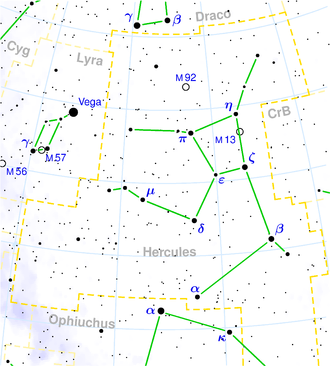Hercules A
| Galaxy Hercules A |
|
|---|---|

|
|
| Overlay of a recording in the visible spectrum of the Hubble Space Telescope with a recording in the radio range of the VLA . | |
| AladinLite | |
| Constellation | Hercules |
|
Position equinox : J2000.0 , epoch : J2000.0 |
|
| Right ascension | 16 h 51 m 08.15 s |
| declination | + 04 ° 59 ′ 33.32 ″ |
| Appearance | |
| Physical data | |
| distance | 2100 M ly |
| history | |
| Catalog names | |
| PGC 59117 • MCG + 01-43-006 • 2MASX J16510802 + 0459349 • Hercules A • 3C 348 • GALEXASC J165108.40 + 045932.3 | |
Hercules A is an elliptical radio galaxy 2.1 billion light years away in the eponymous constellation Hercules .
In images in the visible spectral range, Hercules A appears as a typical elliptical galaxy. However, observations in the radio range show plasma jets over a million light years in size . Further considerations indicate that the galaxy, also known as 3C 348, with around 10 15 solar masses has 1,000 times the mass of the Milky Way , and that its central black hole with 4 billion solar masses also has 1,000 times the mass of the Milky Way and thus one of the biggest known ones. Although the physics behind the jets is not yet entirely clear, their energy probably comes from the flow of matter to the black hole.
swell
- ↑ A Multi-Wavelength View of Radio Galaxy Hercules A . NASA. Retrieved June 27, 2014.
- ↑ Plasma Jets from Radio Galaxy Hercules A at NASA Astronomy Picture of the Day . Portions of this public domain text are used here.
